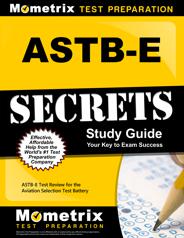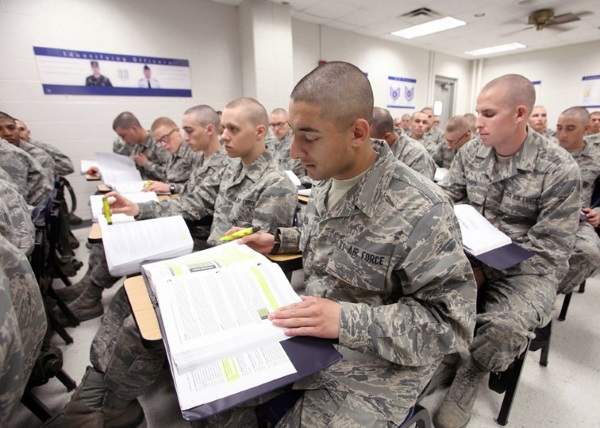The Aviation Selection Test Battery (ASTB) helps the Navy, Marine Corps, and even the Coast Guard select the best applicants to become pilots and undergo officer training.
Therefore, potential applicants need an ASTB study guide.
There are several sections of the ASTB, and a servicemember can choose to take the whole test for the aviation test of the aptitude portions for Officer Training programs.
Since a test like the ASTB-E helps determine future careers, being prepared with study tips is vital.
Looking To ACE The ASTB-E Test?
 If you’re looking for an effective test prep course to help you ace the ASTB test, we recommend you check out a program called the ‘ASTB-E Secrets Study Guide‘.
If you’re looking for an effective test prep course to help you ace the ASTB test, we recommend you check out a program called the ‘ASTB-E Secrets Study Guide‘.
It’s specifically designed to help you ACE the ASTB-E test in the shortest time possible.
Instead of having to study endlessly for months, you’ll be able to study for just a couple of weeks…AND get a better score!
Click Here to check it out!
Table of Contents
ASTB Study Guide Tip #1: Practice

While part of the ASTB measures aptitude and there is little you can do for studying, other sections require time to study and target skills.
Therefore, it is vital to take a practice test to determine which subtests are your weakest.
Once you pinpoint areas of struggle, you can set up a study schedule to increase your scores in those areas.
Specific areas of study include reading comprehension, math, and Aviation and Nautical Information.
While reading comprehension and math can be a challenge, the Aviation Informational subtest covers an impressively wide angle of topics.
Therefore, your study plan should include that topic regardless of the outcome of your practice test as it relates to the Aviation Information section.
Also, once you work through your weakest subject areas, take another practice exam to recalibrate your study plan.
ASTB Study Guide Tip #2 Review the Rationale
After taking your practice exam, an ASTB study guide tip is to look at all your wrong answers.
When you look to figure out what you got wrong, evaluate the correct answer.
By taking the time to understand the rationale behind the right and wrong answers, you improve your critical thinking skills.
Taking tests is not solely a reflection of what you know; tests also reflect your ability to solve problems.
Therefore, having a mindset and practice of rationalizing all answer choices will set you up for success for the ASTB and any other future high-stakes test.
Related Article – ASBAV Scores and the Military Jobs that Qualify
ASTB Study Guide Tip #3 Priorities and Learning
As you continually study and learn, recalibrate your time by cycling in new areas to improve.
Also, be aware that your brain needs time to rest to ensure new learning goes from short-term memory into long-term memory and becomes a part of your schema.
A schema is the framework of the brain that organizes and stores information.
As you learn, you are adding more to the schema.
The next time you learn something new, you have a little bit of knowledge to attach your new thinking.
For instance, if you are studying up your math skills, you might study and learn a new skill.
Next, you take a break and perhaps study something related to reading comprehension.
By the time you get back to math, your brain is rested, and your new information is available to attach new learning.
As you study, you prioritize your learning to optimize how your brain works.
Long-term learning is the goal of your study and preparation plan.
However, it is worth noting that often people do cram for tests, even if it is not advised.
In that case, a strategy is a brain dump where you use your scratch paper to write down everything you can remember from your cram session before you forget the information.
You jot down your notes right at the beginning of the ASTB.
ASTB Study Guide Tip #4 Be Decisive
Decisiveness is the ability to make decisions quickly and without anxiety.
When you take tests, you will find answer options to questions you do not know.
In those situations, it is essential to remain calm and look at the question logically.
A test-taking strategy is to use inferencing skills to evaluate both the question and potential answers.
Inferencing is another way of saying educated guess.
Usually, test answers have one to two answer choices that are easy to eliminate.
Even if you do not know the answer after eliminating two, you raise your odds of getting the question correct to 50 percent.
ASTB Study Guide Tip #5 Set a Goal
Know what score you are aiming for and keep that in mind as you study, take practice exams, and evaluate your work.
The ASTB-E scores have many uses, and different military branches use the test and the scores in different ways.
Therefore, you have to evaluate your end plan.
Ideally, you already have a career goal in mind, and you know what parts of the scores and composites relate to your goals.
From there, you should evaluate what a competitive score is to you.
As you take your practice test and work through study cycles, it fits your end goal and score in mind.
That way, the work you do has focus and intent, which leads to intentional learning.
Related Article – 12 ASVAB Tips & Tricks To Help You Get The Best Score
Frequently Asked Questions (FAQ)

We address frequently asked questions below regarding the ASTB and ASTB study guide.
What are the subtests in the ASTB-E?
There are seven subtests to the ASTB-E.
Reading Comprehension
The reading comprehension subtests reveal how well an applicant can pull out important information about a text.
Often, the questions require inferencing skills, which is another way of saying make an educated guess based on text evidence.
For applicants interested in the Officer Aptitude Rating (OAR) portion of the ASTB-E, the reading comprehension subtest is the first section that makes up the OAR.
Math Skills
The math skills portion of the exam covers the ability to use basic math skills, algebra, and even geometry.
You can expect word problems on this portion of the test, as well.
The math skills section is the second part of the AOR for those looking into Officer Training programs.
Mechanical Comprehension
The mechanical comprehension test covers physics and applied sciences as it relates to mechanics.
This subtest is the third portion and final part that makes up the OAR.
Aviation and Nautical Information Test
This section of the exam covers aviation history and nautical terms and procedures.
Also, expect this subtest to be more a reflection of knowledge over aptitude.
Therefore, it is essential to brush up on facts, because this area includes a rich history and a wide range of topics.
Naval Aviation Trait Facet Inventory
The Naval Aviation Trait Facet Inventory is not a subtest for which you can study.
You will pair statements that reveal personality traits that tend to predict future success in aviation.
Performance-Based Measures Battery
This section of the exam covers processing speed and agility.
Also, this is a measure of spatial orientation and working quickly with divided attention.
Flight simulation software is excellent practice for this section.
Biographical Inventory with Response Validation
This final section of the ASTB-E covers previous work experience and can be done at any time.
Ideally, this is complete before the test day.
Related Article – Navy Pilot Requirements: 11 Steps To Becoming A Naval Aviator
What is the purpose of the ASTB-E?
The purpose behind the ASTB-E is to determine if an applicant is a good candidate for working in aviation.
Some candidates take the whole exam because they want to work in aviation.
However, a candidate can also take the portion of the exam that qualifies them for Officer Training.
Does everyone take the same test?
The test is multiple-choice, and the first five subtests are adaptive.
An adaptive test works by evaluating the test taker’s skill level and adapting questions based on skill level.
For instance, if you answer three questions in a row correctly, and the fourth question proves to be hard, the following question will change according to your level of knowledge.
Two people taking the same test are likely to have completely different questions.
How long is the ASTB-E?
For those taking the OAR portion of the ASTB, the testing time ranges from an hour and a half to two hours.
For those talking the whole exam, the test time range is typically two to three hours.
What is a good score?

The ASTB takes the subtest scores and creates four composite scores that are weighted differently from one another.
The Academic Qualifications Rating measures academic performance in aviation.
On the other hand, the Pilot Flight Aptitude Rating measures flight performance.
Next, the Flight Officer Aptitude rating measures a candidate’s performance for flight performance for officers.
Lastly, the Officer Aptitude Rating measures performance for Officer Candidate School.
The scores are then used depending on the program for which the service member wants consideration.
For instance, a service member who wants to become an officer will have concern for the OAR scores.
In contrast, another service member who wants to go into Naval Aviation will pay attention to their Academic Qualifications Rating and Pilot Flight Aptitude Rating scores.
An overall average score for the whole exam is between 40 and 60 percent.
Also, each military branch and program has its own set of minimum scores and combinations of component scores.
Related Article – AFOQT: 7 Incredible Tips To Help You Score High
Conclusion
You want to do well on the ASTB, and the ASTB study guide will help you achieve your goals.
Different military branches use the ASTB in different ways, but those taking the exam want to go into aviation and become officers.
By starting with a practice test, you can learn which areas of the test you should study.
Part of your study plan should be to evaluate all your wrong answers and come up with the rationale behind all the wrong and correct answer choices.
This way, you build critical thinking skills that will help you on the ASTB.
Furthermore, you must build your decisiveness when taking tests, and learn how to eliminate answer choices to better your odds.
Lastly, have a goal in mind that relates to which areas of the test will contribute to a score related to your career plans.
The ASTB has different composite scores and depending on your goals, some areas of the test might weigh in higher than others.
References:
www.med.navy.mil
See Also
Becoming A Pilot In The Air National Guard (ANG)
Coast Guard Pilot Requirements
Navy Pilot vs. Air Force Pilot
Marine Corps Pilot Requirements
- Replacing Dog Tags: 6 Things You Need to Know - June 28, 2024
- Navy OAR Test Study Guide - June 24, 2024
- 10 Best Sniper Movies of all Time - June 20, 2024
Originally posted on April 19, 2021 @ 1:08 pm
Affiliate Disclosure: This post may contain affiliate links. If you click and purchase, I may receive a small commission at no extra cost to you. I only recommend products I have personally vetted. Learn more.

